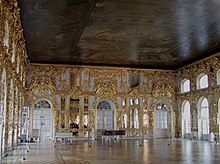Ballroom
**Characteristics of Ballrooms:**
– Ballroom is a large room for formal parties known as balls.
– Traditionally held in private residences, many historic mansions and palaces have ballrooms.
– Good ballrooms have hardwood or stone flooring.
– Ballrooms can also refer to nightclubs designed for dancing events.
– They are typically designed with high ceilings to accommodate dancing.
**List of Hardwood US Floor Ballrooms:**
– Fullerton Ballroom in Fullerton, California, established in 1927 with 2,145 sq. ft.
– Lakeside Ballroom in Guttenberg, Iowa, established in 1927 (specific size not provided).
– Oak Ballroom in Schuyler, Nebraska, established in 1929 (specific size not provided).
– Cains Ballroom in Tulsa, Oklahoma, established in 1924 with 11,000 sq. ft.
– Diamond Ballroom in Oklahoma City, Oklahoma, established in 1964 (specific size not provided).
**Notable Ballrooms:**
– Aragon Ballroom in Santa Monica, California.
– Clärchens Ballroom in Berlin, Germany.
**References:**
– Fullerton Ballroom is 2,145 sq. ft. (established in 1927).
– Cains Ballroom is 11,000 sq. ft. (established in 1924).
– Information on Lakeside Ballroom and Oak Ballroom sizes is unavailable.
– Various sources provide additional data on different ballrooms.
– Specific measurements and details are available for some ballrooms.
**Further Reading:**
– ‘Millennium Maple – Glorious, Historic, Legendary, Treasured Ballroom Dance Floor’ by Robert Meyer.
**External Links:**
– Texas Dance Hall Preservation Inc.
This article has multiple issues. Please help improve it or discuss these issues on the talk page. (Learn how and when to remove these template messages)
|
A ballroom or ballhall is a large room inside a building, the primary purpose of which is holding large formal parties called balls. Traditionally, most balls were held in private residences; many mansions and palaces, especially historic mansions and palaces, contain one or more ballrooms. In other large houses, a large room such as the main drawing room, long gallery, or hall may double as a ballroom, but a good ballroom should have the right type of flooring, such as hardwood flooring or stone flooring (usually marble or stone).[citation needed]. For most styles of modern dance, a wooden sprung floor offers the best surface.


In later times the term ballroom has been used to describe nightclubs where customers dance, the Top Rank Suites in the United Kingdom for example were also often referred to as ballrooms. The phrase "having a ball" has grown to encompass many events where person(s) are having fun, not just dancing.
Ballrooms are generally quite large, and may have ceilings higher than other rooms in the same building. The large amount of space for dancing, as well as the highly formal tone of events have given rise to ballroom dancing. The largest balls are now nearly always held in public buildings, and many hotels have a ballroom. They are also designed large to help the sound of orchestras carry well throughout the whole room.
A special case is the annual Vienna Opera Ball, where, just for one night, the auditorium of the Vienna State Opera is turned into a large ballroom. On the eve of the event, the rows of seats are removed from the stalls, and a new floor, level with the stage, is built.
Sometimes ballrooms have stages in the front of the room where the host or a special guest can speak. That stage can also be used for instrumentalists and musical performers.
